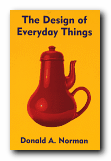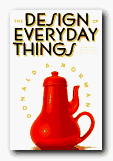why we love (and hate) the everyday objects we use
Donald Norman is famous for The Design of Everyday Things – a best-selling study of the need for functionality in consumer product design. It’s no good having tea pots that don’t pour properly, chairs you can’t sit in, or doorknobs that don’t open the door. Emotional Design is his follow up to that study, in which he revises his views. He confesses that he had previous under-rated the importance of emotions and aesthetics:
in writing The Design of Everyday Things I didn’t take emotions into account … But now I have changed … Sure, utility and usability are important, but without fun and pleasure, joy and excitement…our lives would be incomplete. Along with our emotions, there is one other point as well: aesthetics, attractiveness, and beauty.
The first part of the book is actually concerned with the psychology of our response to objects. He suggests that we perceive them at a visceral, behavioural ,and a reflective level. That is – Do I like it? Does it work? and Will I use it again? The first is instinctive, the second rational, the third a combination of experience and cultural influence, rather like the super-ego.
The second part of the book applies these principles to product design. His examples range from mineral water bottles to web sites, and from hiking boots to industrial vacuum cleaners.
What he does here is to emphasise the desirability of good shape and satisfying textures. The rest is a repeat of what he argued in the earlier book. The product must work easily, and ideally it should be tested for usability (presumably by a company such as the Nielsen-Norman Group).
He is still generally on the side of functionality, but now appears to be prepared to defend the appeal of glamorous surfaces. However, you do begin to wonder about his judgements when he gets excited about owning one of those Martian-looking Philippe Starck lemon juicers which even the designer confesses were “not designed to squeeze lemons [but] to start conversations.”
He gets so carried away that when he comes to analyse the social interactions of text messaging and mobile phone conversations, it’s hard to see what it has to do with design, and much of what he has to say should be fairly obvious to everyone conversant with their advantages and limitations.
He eventually blends this interest in emotions and design by considering the future of robots which have been programmed to have emotions. Not necessarily human emotions, but appropriate for their function and survival.
Strangely enough, the rationale for all this is given in an epilogue which traces the development of his professional career. He has latterly been working with psychologists and now sees that human choices are made on more than functionality alone. [One wonders whether his business partner, the ultra-functionalist Jakob Nielsen is persuaded by this approach.]
This is a lively, thought-provoking study of design principles. Donald Norman writes in a friendly, jargon-free style, and he communicates a humane enthusiasm for his subject. I doubt that this will dislodge The Design of Everyday Things from the top of the Design Classics list, but it is one which anyone with an interest in design will not want to miss.
© Roy Johnson 2003
Donald A. Norman, Emotional Design: why we love (or hate) everyday things, New York: Basic Books, 2003, pp.257, ISBN: 0465051359.
More on design
More on media
More on web design
More on information design


